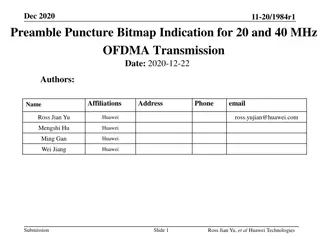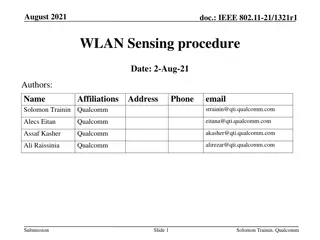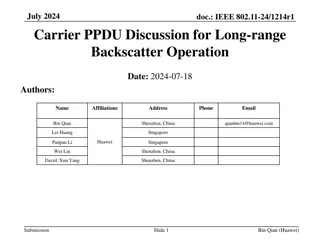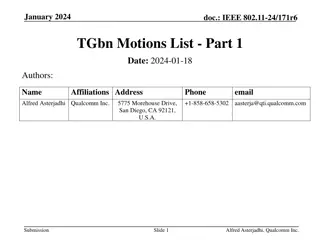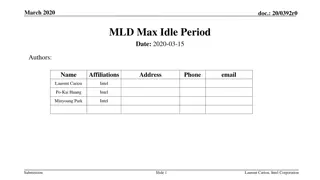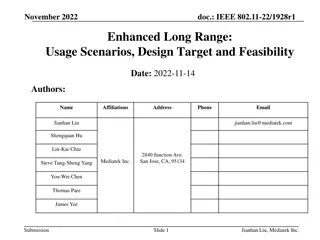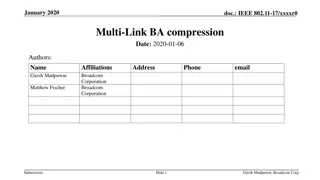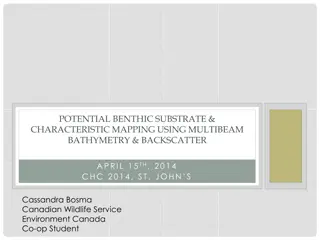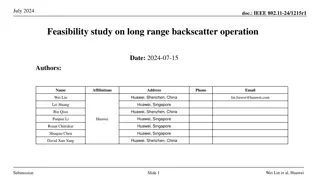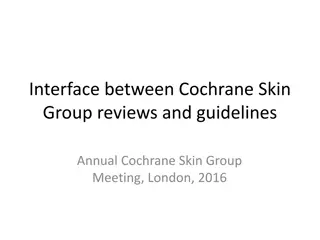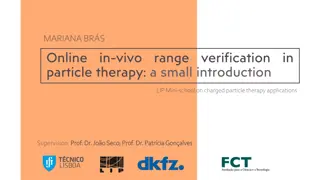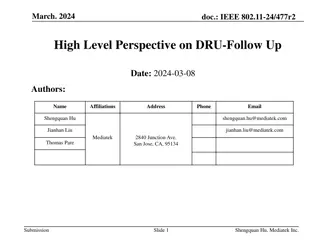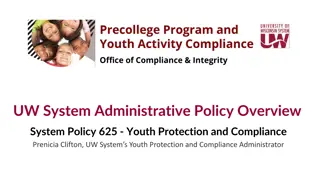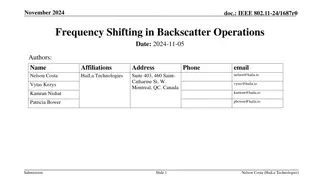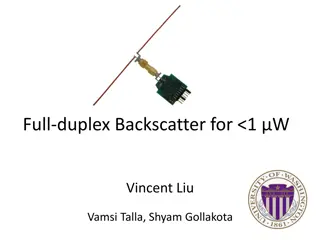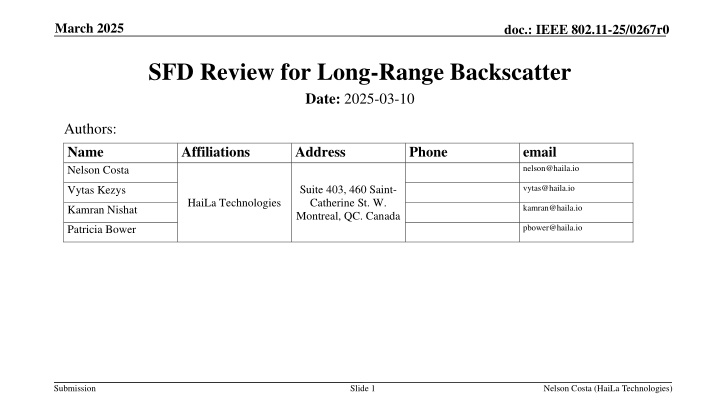
Review of IEEE 802.11-25 Long-Range Backscatter SFD
Explore the review of features in the Specification Framework Document (SFD) for enabling long-range backscatter as an optional mode in IEEE 802.11-25. Discover the necessary SFD features, capabilities, and differences between close-range and long-range backscatter scenarios. Dive into the discussions on specific features required to implement long-range backscatter technology.
Download Presentation

Please find below an Image/Link to download the presentation.
The content on the website is provided AS IS for your information and personal use only. It may not be sold, licensed, or shared on other websites without obtaining consent from the author. If you encounter any issues during the download, it is possible that the publisher has removed the file from their server.
You are allowed to download the files provided on this website for personal or commercial use, subject to the condition that they are used lawfully. All files are the property of their respective owners.
The content on the website is provided AS IS for your information and personal use only. It may not be sold, licensed, or shared on other websites without obtaining consent from the author.
E N D
Presentation Transcript
March 2025 doc.: IEEE 802.11-25/0267r0 SFD Review for Long-Range Backscatter Date: 2025-03-10 Authors: Name Nelson Costa Affiliations Address Phone email nelson@haila.io Suite 403, 460 Saint- Catherine St. W. Montreal, QC. Canada vytas@haila.io Vytas Kezys HaiLa Technologies kamran@haila.io Kamran Nishat pbower@haila.io Patricia Bower Submission Slide 1 Nelson Costa (HaiLa Technologies)
March 2025 doc.: IEEE 802.11-25/0267r0 Abstract In the following, we review features in the Specification Framework Document (SFD, [1]). Our intention is to help identify gaps in the SFD, and help get us closer to D0.1. In the following we try to summarize what is already defined, what is missing, and what features we believe we need to enable long-range backscatter as an optional mode. We attempt to relate SFD features to capabilities that a Backscatter non-AP AMP STA would have. Submission Slide 2 Nelson Costa (HaiLa Technologies)
March 2025 doc.: IEEE 802.11-25/0267r0 Background In [2] we discussed the long-range backscatter use case. The capabilities at the Backscatter non-AP AMP STA for long-range use case differs from that of close-range sticker tag use case. Close-Range "Sticker" Tag Long-Range Tag Lower accuracy clock Higher accuracy clock OOK Modulation in Downlink OOK Modulation in Downlink (same) OOK Modulation in Uplink DBPSK, DQPSK Modulation in Uplink No carrier frequency shifting Carrier frequency shifting Low receive sensitivity: Receiver sensitivity limited by Energy Harvester Higher receive Sensitivity: Not RF Energy Harvester limited Limited energy storage Lifetime battery or larger storage capacity Submission Slide 3 Nelson Costa (HaiLa Technologies)
March 2025 doc.: IEEE 802.11-25/0267r0 Background (2) On further discussion, the group still had some questions. What specific SFD features would be required to enable a long-range backscatter mode? Combined channel shifting and bit flipping. (SSB and PSK modulation in the Uplink) 1 Mb, 2 Mb DSSS in the AMP Excitation field [6-7] [4-5] Medium protection mechanisms for long range backscatter [8] Submission Slide 4 Nelson Costa (HaiLa Technologies)
March 2025 doc.: IEEE 802.11-25/0267r0 SFD So Far: Downlink PPDU Formats In the downlink, the following downlink frame formats are proposed in the SFD Submission Slide 5 Nelson Costa (HaiLa Technologies)
March 2025 doc.: IEEE 802.11-25/0267r0 SFD Downlink PPDU: Receiver Capabilities The DL PPDU clause implies several capabilities at the AMP STA receiver. Submission Slide 6 Nelson Costa (HaiLa Technologies)
March 2025 doc.: IEEE 802.11-25/0267r0 SFD Downlink PPDU: Backscatter Receiver Capabilities Backscatter in the SFD Long-range backscatter Sync sequence design should depend on the receiver s sensitivity level, not whether the device does backscatter or non-backscatter. Focusing on receiver sensitivity, Energy Harvesting sensitivity is limited to around -23 dBm. [3] Our current long-range tags have around -35 to -40 dBm receiver sensitivity and are not EH limited. Active Tx devices are already assumed to have better receive sensitivity. Next generation long-range backscatter tags in newer process nodes will have better receiver sensitivity and consume less power. Submission Slide 7 Nelson Costa (HaiLa Technologies)
March 2025 doc.: IEEE 802.11-25/0267r0 SFD So Far: Uplink PPDU Formats The SFD is missing the most detail regarding the definition of uplink PPDUs. Submission Slide 8 Nelson Costa (HaiLa Technologies)
March 2025 doc.: IEEE 802.11-25/0267r0 SFD Uplink PPDU: Transmitter Capabilities The UL PPDU clause implies several capabilities at the AMP STA transmitter. Submission Slide 9 Nelson Costa (HaiLa Technologies)
March 2025 doc.: IEEE 802.11-25/0267r0 Uplink PPDU: Backscatter Transmitter Capabilities Backscatter in the SFD Long-range backscatter [4-5] We proposed using 1 or 2 Mb DSSS in the Excitation field. This forms the entire UL PPDU after backscatter. [6] We proposed using bit flipping or PSK modulation in the uplink. Bit flipping means the AMP STA only changes the phase of the chips already embedded in the downlink sequence. It does not generate pulses using OOK. [6-7] We present how we can do channel shifting and DBPSK, DQPSK modulation at the same time. This implies both 1 and 2 Mb uplink rate for free . Submission Slide 10 Nelson Costa (HaiLa Technologies)
March 2025 doc.: IEEE 802.11-25/0267r0 Uplink PPDU: Backscatter Transmitter Capabilities (2) Long-range backscatter Backscatter in the SFD [8] Using 1 or 2 Mb DSSS in the Excitation field and channel shifting gives us the Sync in the uplink for free . The tag doesn t need to generate the Sync sequence; it can simply backscatter the exiting sequence! The pre-embedded training sequences are critical for bistatic long-range applications. [3-6] Using channel shifting gets us > 50 dB more link margin for long-range backscatter applications. Submission Slide 11 Nelson Costa (HaiLa Technologies)
March 2025 doc.: IEEE 802.11-25/0267r0 Conclusion In this presentation, we discussed our interpretation of the current draft SFD. In particular, we focused on the AMP DL PPDU and AMP UL PPDU formats, and how they map to the long-range backscatter use case. We discussed what features we believe would be needed to enable a long- range backscatter use case. AMP DL PPDU: Longer Sync sequence, the design should be determined by receiver sensitivity not backscatter vs. non-backscatter. 1 and 2 Mb DSSS PPDU as an optional waveform for the Excitation field. AMP UL PPDU: Channel shifting (Single Sideband Modulation) and PSK modulation in addition to OOK. Submission Slide 12 Nelson Costa (HaiLa Technologies)
March 2025 doc.: IEEE 802.11-25/0267r0 References [1] Qi, Yinan, Specification framework for TGbp, 11-24/1613, September 2024. [2] Costa et al., Long-Range Backscatter Use Case, 11-24/2115, January 2025. [3] Shellhammer et al., WUR for Integrated Energizer Case, 11-24/1163, July 2024. [4] Costa et al., Advantages of 802.11b DSSS in Long-Range Backscatter, 11-24/2143, January 2025. [5] Kezys et al., Low Complexity Backscatter AMP STA, 11-24/2002, November 2024. [6] Costa et al., PSK Modulation for Long-Range Backscatter, 11-25/0266, March 2025. [7] Costa et al., Single Side Band Backscatter Modulation, 11-25/0265, March 2025. [8] Nishat et al., Long-range Backscatter Protection Mechanisms, 11-25/0264, March 2025. Submission Slide 13 Nelson Costa (HaiLa Technologies)

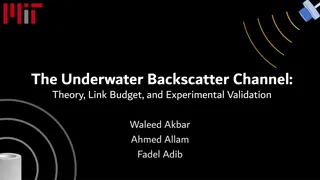
![Long-Range Wireless Charging Market Report & Analysis _ BIS Research [2024-2035]](/thumb/87166/long-range-wireless-charging-market-report-analysis-bis-research-2024-2035.jpg)
